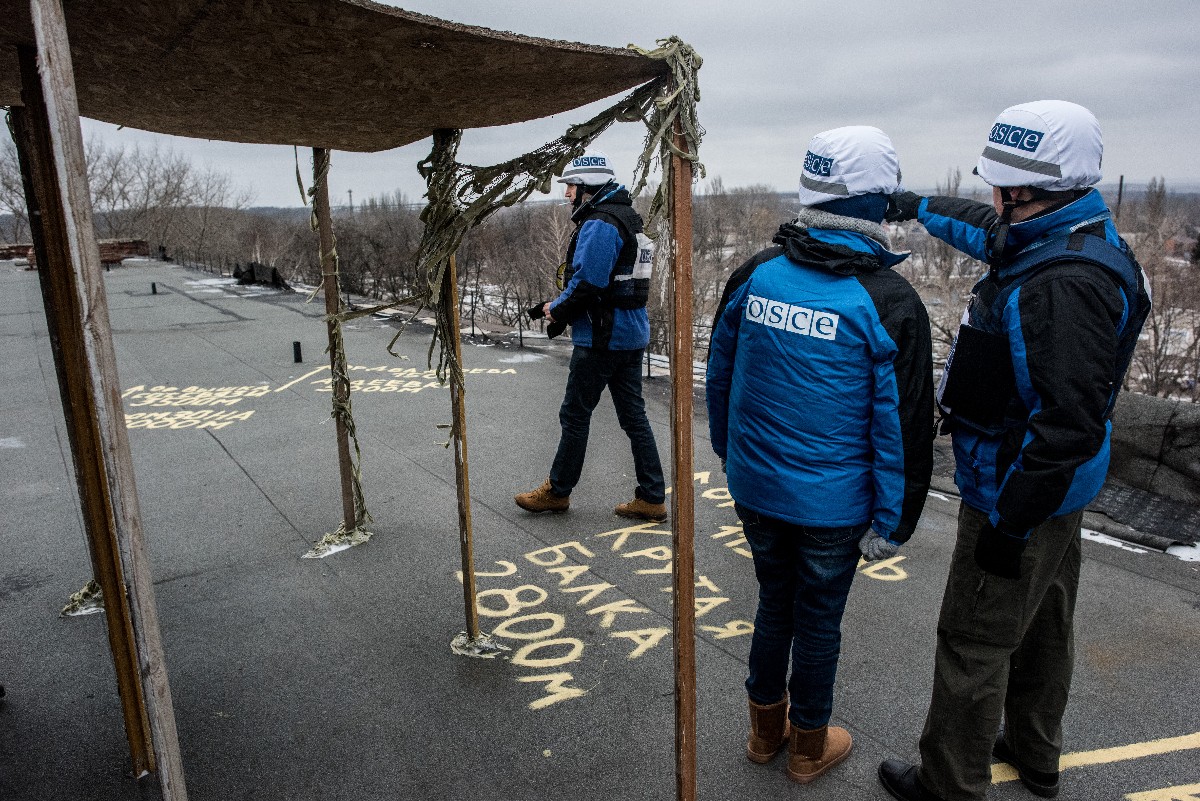 Image Credit: OSCE
Image Credit: OSCE
Tightening the Leash: The Kremlin and Eastern Ukraine
Following the seizure of Crimea in 2014, Russia began a campaign to foment unrest in the eastern Ukrainian regions of the Donbass. The campaign led to the creation of separatist movements, largely financed and manned by the Russian government, calling themselves the People’s Republics of Donetsk and Luhansk; some separatists and Russian media sources refer to them as “Novorossiya” referencing a historical name from the time of Imperial Russia. These separatists launched a military campaign against the Ukrainian government, which has become another “frozen conflict” that Russia continues to feed and benefit from. Russian actions over the course of 2016 and early 2017 fit a pattern of asserting further control over the movements through economic and political integration, indoctrination, and force.
How does Russia benefit from the conflict?
The establishment of a frozen conflict within Ukrainian borders benefits the Russian Federation in multiple ways. First and foremost, the lack of full control over one’s own territory precludes a country from joining premier Western institutions like NATO. One of the reasons Georgia has been unable to join NATO is the existence of the Russian-sponsored breakaway regions of Abkhazia and South Ossetia. Second, it provides a means for Russia to use military resources to gain leverage over Ukraine and keep it from successfully pursuing major foreign policy shifts against Russian interests. Fresh separatist offensive may be launched to distract or deter any such attempts. Finally, the conflict has provided the Kremlin with ample political capital and domestic popularity by stoking nationalist sentiment within Russia. This last benefit is particularly important given the recent protests throughout Russia and 2018’s upcoming presidential election.
What is Russia trying to do now?
Although Russia is the prime patron for the separatist movements, it does not have complete control over them. Separatist leaders may be tempted to launch major offensives without Russian permission, commit war crimes that embarrass Russia, or threaten to divulge information on key moments in the conflict, such as the downing of MH17, that could solidify Western support for Ukraine. To remedy this, some separatist leaders, such as Igor Strelkov, were ordered to return home where they were subject to a media blackout against their will.
There has also been over a dozen assassinations carried out against prominent, highly nationalist, separatist leaders such as “Motorola” and “Gigi,” including one in a Moscow restaurant. It is not clear who is behind the string of assassinations; suspects include Ukrainian special forces, rival separatist commanders, and the Russian government. It is possible that Ukrainian special forces were behind some of the assassinations, but the circumstances of some of the targets seem beyond Ukrainian capabilities. If the assassinations had been largely carried out by rival separatist commanders, there would likely be more signs of infighting between separatists. A portion of these killings could be interpreted as Kremlin-directed, or at least Kremlin-approved, to remove troublesome personalities and consolidate control. This would fit the pattern of Russia’s broader actions towards the separatists.
Following the Ukrainian government’s decision to blockade them, the separatists announced that they would henceforth carry out all transactions in Russian rubles. At the same time, Russia has continuously donated funds and resources to educational programs that glorify Russia and the Soviet past; school curriculums in Donetsk and Luhansk have shifted their focus to Russian textbooks, Russian history, and harmonizing with Russian educational administrative practices. According to rebel defectors, Russian funds make up the majority of the separatist budget. Russia also provides energy to the separatists, and the separatist territories continue to pursue integration into the Russian market. More concerningly, separatist media sources continue to produce articles arguing for integration into the “Russian space,” and Russian media provides coverage to separatist leaders’ intentions for a future referendum on joining Russia. Taken together, these actions suggest that Russia wants to maximize its range of options regarding the separatists.
Without strict control of the separatists, the Kremlin risks a situation in which they make a major decision unilaterally by making a key concession or launching a major offensive. By maintaining control, the Kremlin can decide what happens and when. The coverage given to the idea of a referendum and future annexation is especially worrying. Putin is up for reelection in 2018 and, although he remains personally popular, the recent All-Russia and Platon protests across Russia mean that he cannot take his popular mandate for granted. The annexation of Crimea was tremendously popular in Russia. A worried Putin may be tempted to use another annexation to again rally support.





